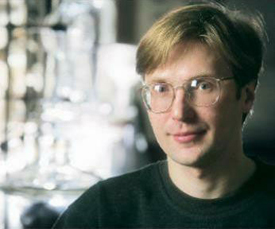Dr. Igor V. Alabugin
Igor V. Alabugin, Ph.D. is Associate Professor of Chemistry and Biochemistry at Florida State University. His research interests are at the intersection of photochemistry, organic synthesis, and supramolecular chemistry with biochemistry and materials science.
The major theme in his research is the use of light as a driving force for chemical transformations. Light is not only a natural phenomenon bringing life to Earth but also a unique chemical reagent. It is environmentally clean and can be used to promote highly selective and efficient chemical reactions. In his research, he explores unique properties of light for the promotion of new molecular and supramolecular transformations.
The ScienceDaily article Chemists Kill Cancer Cells With Light-activated Molecules describes the application of new molecules devoped in Dr. Alabugin’s lab for the design of light-activated anticancer drugs.
“When one of the two strands of our cellular DNA is broken, intricate cell machinery is mobilized to repair the damage,” he said. “Only because this process is efficient can humans function in an environment full of ultraviolet irradiation, heavy metals and other factors that constantly damage our cells.”
However, a cell that sustains so much damage that both DNA strands are broken at the same time eventually will commit suicide — a process known as apoptosis.
“In our research, we’re working on ways to induce apoptosis in cancer cells — or any cells that have harmful genetic mutations — by damaging both of their DNA strands,” Alabugin said. “We have found that a group of cancer-killing molecules known as lysine conjugates can identify a damaged spot, or ‘cleavage’, in a single strand of DNA and then induce cleavage on the DNA strand opposite the damage site. This ‘double cleavage’ of the DNA is very difficult for the cell to repair and typically leads to apoptosis.” This research is described in a 2007 paper published in Proceedings of the National Academy of Sciences.
The possibility of triggering this transformation by light is especially important because it will allow time- and space-controlled activation of an anticancer drug. In other words, he would be able to develop new drugs which start to work only in the right place and at the right time upon irradiation with cell-permeable photons.
Igor coauthored 44 papers and 2 book chapters including Lysine-Enediyne Conjugates as Photochemically Triggered DNA Double-Strand Cleavage Agents, Triplet acetylenes as Synthetic Equivalents of 1,2-Dicarbenes: Phantom n,p* State Controls Reactivity in Triplet Photocycloaddition, Electronic Basis of Improper Hydrogen Bonding: A Subtle Balance of Hyperconjugation and Rehybridization, and Effect of Double Hyperconjugation on the Apparent Donor Ability of -Bonds: Insights From the Relative Stability of -Substituted Cyclohexyl Cations. Read the full list of his publications!
Igor earned his M.Sc. in Chemistry from Moscow State University in 1991 and his Ph.D. in Organic Synthesis from Moscow State University in 1995. He was awarded the Morozov Fellowship four times in 1988, 1989, 1990, and 1991, the NATO Science Fellowship in 1996, 3M Untenured Faculty Awards in 2003 and 2004 as well as Young Investigator from Inter-American Photochemical Society in 2005. He serves as a reviewer for 25 peer-reviewed journals and 5 funding agencies. He was an invited, plenary or a keynote speaker at 16 international conferences.
